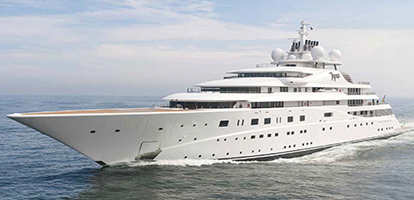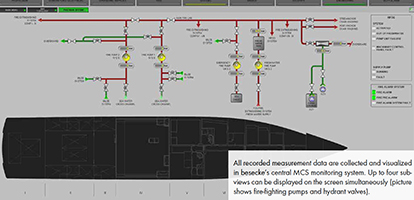


At 100 meters long and equipped with engines providing tens of thousands of HP, the yacht represents a new high in design and commissioning for the Bremer Lürssen shipyard. The firm is the world leader in constructing mega yachts up to 60 meters in length. The automation system was designed, planned,and realized by besecke, a subsidiary of the Lürssen shipyard. The long-time specialist for ship automation relied on 125 WAGO ETHERNET controllers (750-881/882).
The bar was set extremely high – in terms of innovation, customization, and technical perfection – for the luxurious mega yacht, which made automation a great challenge, even for a specialist like besecke. The mid-sized, German company has a workforce of approximately 175 spread among three facilities in Bremen, Emden and Riga. Due to its proximity to the Lürssen shipyard, the “Ship Automation” business unit is primarily based at the Bremen headquarters. The Ship Automation portfolio includes: design and construction of control cabinets and central control systems, development of application-specific software for control units, a proprietary central monitoring control system (MCS), control of the power distribution system, onboard safety monitoring, as well as technical support for the entire lifespan of a ship.
Advancing in New Dimensions
A large number of signals need to be collected, processed and visualized on the mega yacht. The areas to be monitored and controlled include: the ship’s engine, generators, door positions, hydrant valves, fire alarms, National Marine Electronics Association (NMEA) data, security, fill levels, operating hours, alarm services, wastewater, helicopter landing pad, anchor winch, power management (EPMS), HVAC, video surveillance (CCTV), as well as maintenance and entertainment systems.
When combined, more than 10,000 raw signals must be processed for the mega yacht. The WAGO controllers directly collect approximately 5,000 signals. The remaining 5,000 signals are recorded via specialty communication modules. The main engines and generators create the highest data volume, with up to 700 signals to be recorded by each controller. In the MCS, approximately 10 variables are created from the raw signals, e.g., warnings, color changes, or service messages from a pressure or temperature sensor. From the 10,000 recorded data points measured, a total of about 100,000 variables flow into besecke’s central MCS for further processing. To ensure the continuous availability of this huge amount of data, the controllers require extremely highperformance CPUs.
“In general, the trend in luxury yacht automation is toward a constantly growing number of signals to be processed. Furthermore, customers expect more and more information to be visualized via a central monitoring system,“ explains Henry Fischer, Sales Manager at besecke in Bremen. “This in turn requires increasing computing power, without increasing the dimensions of the control units. It’s nearly impossible to get more compact than the WAGO controllers.“
High-Performance Controllers Keep Data Flood under Control
What Fischer is referring to are the 125 programmable ETHERNET controllers (750-881/882), which are used as distributed control units and form the basis for the yacht’s automation solution. The controllers are mounted close to the measuring points, minimizing the amount of individual wiring between the I/O modules on the automation level and the sensors and actuators in the field. Both PLC functionality and an integrated web server make the controllers fully independent. These modular units simplify configuration, start-up, and operation, as well as maintenance and future expansions. These units also increase both reliability and system availability, since controller failures will not impact the overall system. This eliminates the need for a complex, redundant server configuration.
The on-board automation configuration is based on a 1 Gbit ETHERNET fiber optic ring. A ring switch interfaces 100 Mbit copper cables with the individual controllers, creating a uniform ETHERNET configuration from the field up to the control level. Furthermore, the WAGO controllers (750-881/882) feature a two-port switch or two independent ETHERNET ports, simplifying the creation of line topologies. The numerous systems and interfaces are integrated into the central MCS. The controllers provide the collected data points measured and alarm messages to the displays at the monitoring stations via a besecke-developed OPC server, which is six times faster than commercially available products. Cross-communication between controllers is carried out using Modbus/UDP, with each device serving as a master or slave. CODESYS codes can be automatically created from an Excel parameter list using a program developed by besecke. Alarms are processed by the controllers in a standardized manner, making them less prone to errors.
“WAGO’s components are extremely robust and fail-safe. The I/O system’s modularity permits easy and fast retrofitting of individual modules,” says Fischer. “This is important for us, since, of course, requirements may evolve during a project spanning 1.5 years, from order to delivery. Due to the wide range of signals, we opted for fast ETHERNET controllers, which – despite their compact design – provide high computing power and feature two ETHERNET ports. The high-performance CPUs were a basic prerequisite for implementing our monitoring system.”
Full Control from the Bridge to the Engine Room
The modular and fieldbus-independent WAGO-I/O-SYSTEM is an ideal automation solution for shipbuilding. The system has consistently demonstrated its suitability for marine applications aboard various Lürssen yachts, over hundreds of nautical miles in rough seas. Therefore, the components have received all required international shipbuilding approvals, such as GL, LR, DNV, BV, RINA, KR, NK, and BSH. Given these qualifications, direct operation on combustion engines and compressors, as well as operation near the compass are allowed. Therefore, the WAGO-I/O-SYSTEM permits consistent automation solutions from the engine room right up to the bridge.
In addition to the technical features of the WAGO-I/O-SYSTEM, good cooperation and proactive support also contributed to the long-term, close partnership between WAGO and besecke. “We can see that ETHERNET has prevailed over other fieldbus systems in yacht automation applications. The future calls for open, nonproprietary solutions, as offered by WAGO and besecke,” concludes Fischer.
Text: Joerg Schomacker, WAGO
Photo: Luerssen Yachts, besecke